Cultural Enforcement: Difference between revisions
m (typo) |
(some better examples, and working links into context rather than just sentences that might as well be "see also") |
||
| Line 1: | Line 1: | ||
[[File:LOTR- | [[File:LOTR-EN10S028.0_card.jpg|right|frame|link=Denethor, Lord of Minas Tirith (10R28)|''Denethor, Lord of Minas Tirith has very strong cultural enforcement. He's only useful in a deck with many other cards of the same culture.'']] | ||
'''Cultural Enforcement''' is the mechanism used throughout the LotR-TCG to enforce the use of specific [[culture]]s (similar to the use of colored mana costs in Magic: the Gathering). Cards with cultural enforcement require you to play them as part of a deck that focuses on that specific [[culture]] to a greater or lesser degree, depending on the intended power level of the card. Usually this takes the form of [[spot]]ting, [[exert]]ing, or targeting cards of a particular culture, but in some cases this is done more indirectly. | '''Cultural Enforcement''' is the mechanism used throughout the LotR-TCG to enforce the use of specific [[culture]]s (similar to the use of colored mana costs in Magic: the Gathering). Cards with cultural enforcement require you to play them as part of a deck that focuses on that specific [[culture]] to a greater or lesser degree, depending on the intended power level of the card. Usually this takes the form of [[spot]]ting, [[exert]]ing, or targeting cards of a particular culture, but in some cases this is done more indirectly. | ||
| Line 10: | Line 10: | ||
* Utilizing mechanics which are used primarily by one culture ([[roaming]] minions for {{C|Gondor}} '''[[Ranger]]s''', mass [[archery]] for the {{C|Elven}} culture). | * Utilizing mechanics which are used primarily by one culture ([[roaming]] minions for {{C|Gondor}} '''[[Ranger]]s''', mass [[archery]] for the {{C|Elven}} culture). | ||
The more cultural requirements, the stronger the enforcement is (and theoretically, the stronger or more thematic the effect you purchase as a result). | The more cultural requirements, the stronger the enforcement is (and theoretically, the stronger or more thematic the effect you purchase as a result). Denethor, Lord of Minas Tirith (pictured at the right) is an example of a card with very strong cultural enforcement. He has to spot two other {{C|Gondor}} [[Man|men]] just to be played, and once on the table his ability doesn't even work except with {{C|Gondor}} culture cards. On the other hand, your investment into that culture purchases you the ability to pull any {{C|Gondor}} cards you want from your deck, which cannot be underestimated. | ||
In contrast, {{Card|Legolas, Greenleaf}} has very weak cultural enforcement | In contrast, {{Card|Legolas, Greenleaf}} has very weak cultural enforcement. [[Splash]] him into any Free Peoples deck and he just does his own thing, cheerfully [[direct wounding|wounding and killing]] any troublesome minions without needing any other {{C|Elven}} cards to function. He can certainly fit into an {{C|Elven}} deck, especially one that can heal him after he's [[exert]]ed with cards like {{Card|Elrond, Herald to Gil-Galad}} or {{Card|Shadow Between}}, but he fits just as well into a [[rainbow]] deck like [[Rainbow Wounding]]. | ||
Cultural enforcement is often layered or stacked, such as with {{Card|Madril, Loyal Lieutenant}}, which not only | Cultural enforcement is often layered or stacked, such as with {{Card|Madril, Loyal Lieutenant}}, which not only refers to {{C|Gondor}} culture, but also the '''[[Ranger]]''' keyword (which is [[Arwen, Daughter of Elrond (1R30)|almost]] [[Arwen, Elven Rider (3U7)|exclusive]] to {{C|Gondor}}) and manipulation of minion [[Site Number|site number]]s (an exclusively '''Ranger'''-y thing to do). Madril was designed for a very specific deck, full of {{C|Gondor}} '''Rangers''' that cause minions to become [[roaming]] then uses cards like {{Card|What Are They?}} or {{Card|Ranger's Bow}} against them. | ||
In general, "cultural enforcement" is only used when referring to cards that look at or affect your own cards. Cards that ''harm'' a particular culture that your opponent is playing are called [[hate]] cards. | In general, "cultural enforcement" is only used when referring to cards that look at or affect your own cards. Cards that ''harm'' a particular culture that your opponent is playing are called [[hate]] cards. | ||
Revision as of 05:36, 16 February 2022
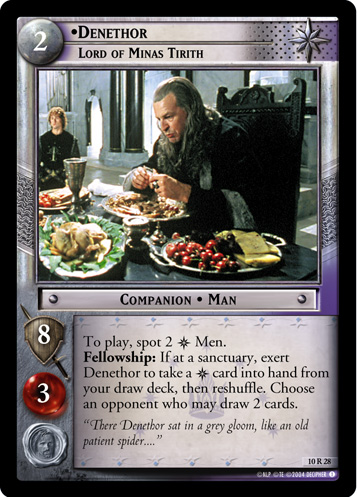
Cultural Enforcement is the mechanism used throughout the LotR-TCG to enforce the use of specific cultures (similar to the use of colored mana costs in Magic: the Gathering). Cards with cultural enforcement require you to play them as part of a deck that focuses on that specific culture to a greater or lesser degree, depending on the intended power level of the card. Usually this takes the form of spotting, exerting, or targeting cards of a particular culture, but in some cases this is done more indirectly.
Such indirect methods include:
- Referring to a specific Race that only appears in one culture (Dwarf for the
Dwarven culture, Nazgul for
Ringwraith).
- Referring to unique individuals by name who are only part of one culture (Gandalf for
Gandalf, Theoden for
Rohan).
- Referring to keywords or combinations of keywords which are exclusive subcultures of a particular culture (besiegers for
Sauron, Ring-bound Rangers for
Gondor).
- Utilizing mechanics which are used primarily by one culture (roaming minions for
Gondor Rangers, mass archery for the
Elven culture).
The more cultural requirements, the stronger the enforcement is (and theoretically, the stronger or more thematic the effect you purchase as a result). Denethor, Lord of Minas Tirith (pictured at the right) is an example of a card with very strong cultural enforcement. He has to spot two other Gondor men just to be played, and once on the table his ability doesn't even work except with
Gondor culture cards. On the other hand, your investment into that culture purchases you the ability to pull any
Gondor cards you want from your deck, which cannot be underestimated.
In contrast, Legolas, Greenleaf (1R50)
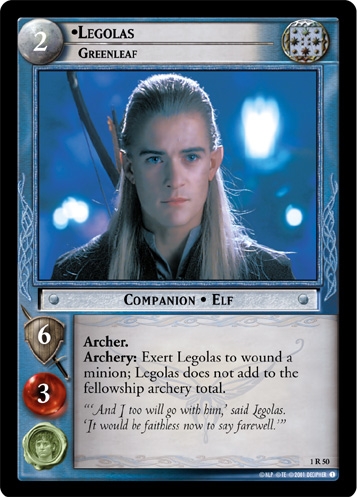 has very weak cultural enforcement. Splash him into any Free Peoples deck and he just does his own thing, cheerfully wounding and killing any troublesome minions without needing any other
has very weak cultural enforcement. Splash him into any Free Peoples deck and he just does his own thing, cheerfully wounding and killing any troublesome minions without needing any other Elven cards to function. He can certainly fit into an
Elven deck, especially one that can heal him after he's exerted with cards like Elrond, Herald to Gil-galad (3R13)
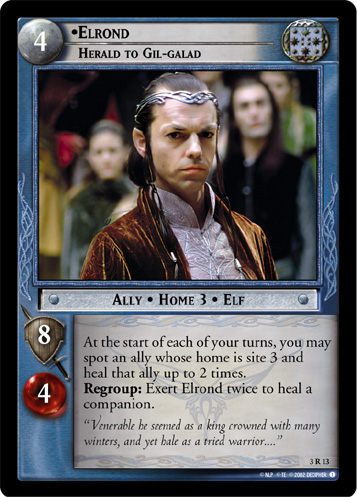 or Shadow Between (7R28)
or Shadow Between (7R28)
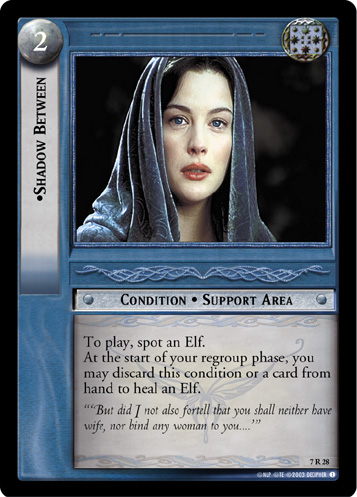 , but he fits just as well into a rainbow deck like Rainbow Wounding.
, but he fits just as well into a rainbow deck like Rainbow Wounding.
Cultural enforcement is often layered or stacked, such as with Madril, Loyal Lieutenant (17S30)
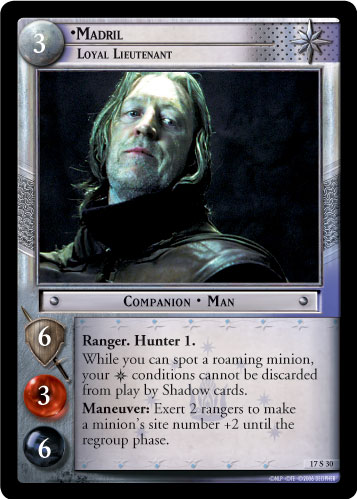 , which not only refers to
, which not only refers to Gondor culture, but also the Ranger keyword (which is almost exclusive to
Gondor) and manipulation of minion site numbers (an exclusively Ranger-y thing to do). Madril was designed for a very specific deck, full of
Gondor Rangers that cause minions to become roaming then uses cards like What Are They? (1C119)
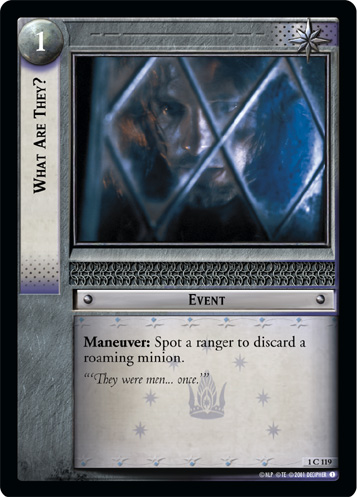 or Ranger's Bow (4C131)
or Ranger's Bow (4C131)
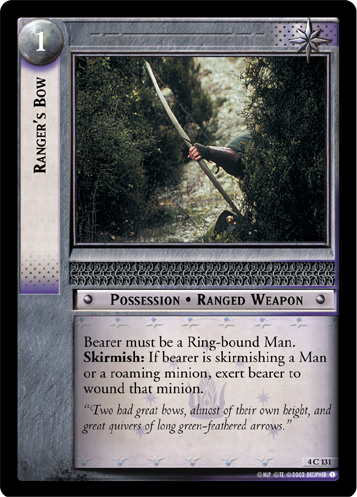 against them.
against them.
In general, "cultural enforcement" is only used when referring to cards that look at or affect your own cards. Cards that harm a particular culture that your opponent is playing are called hate cards.